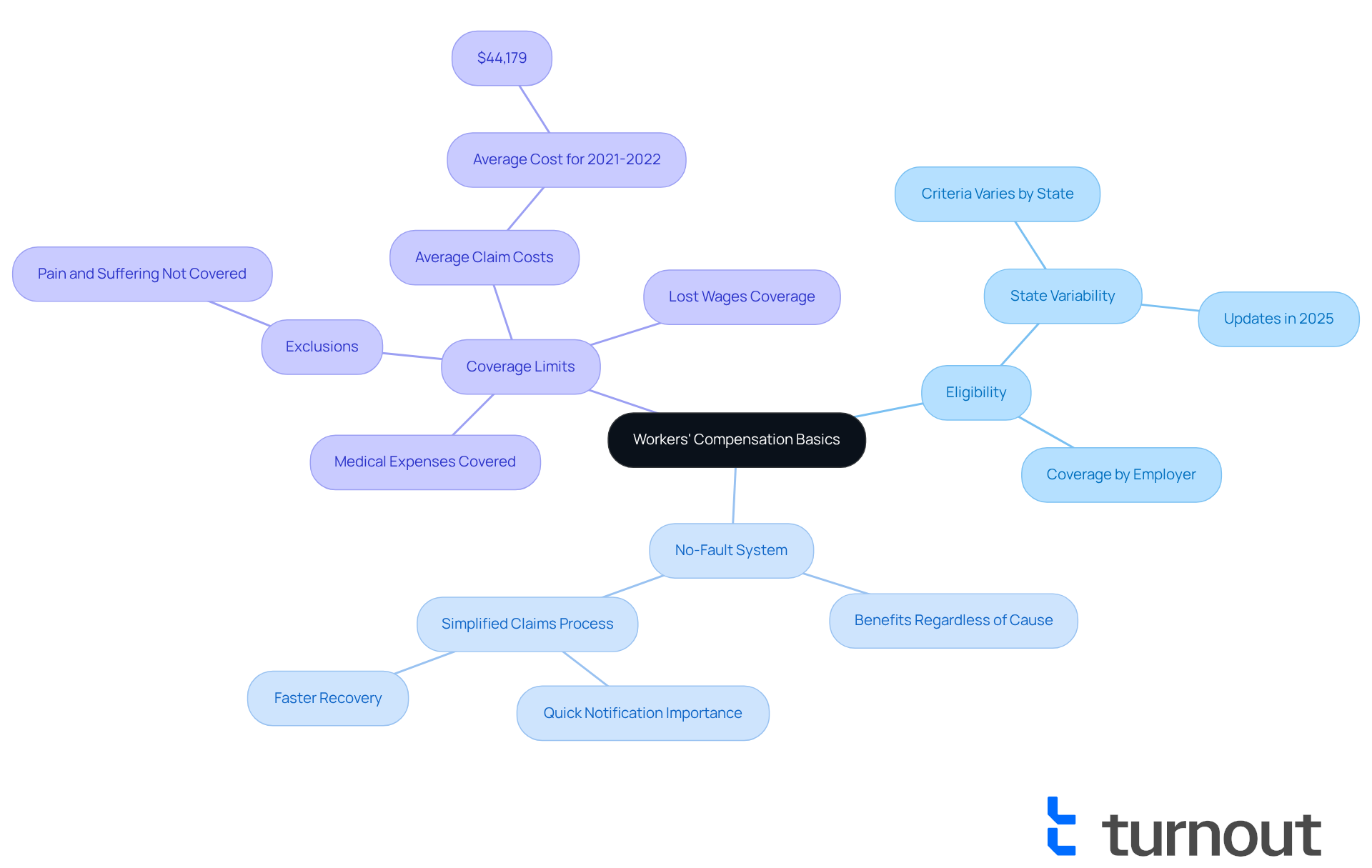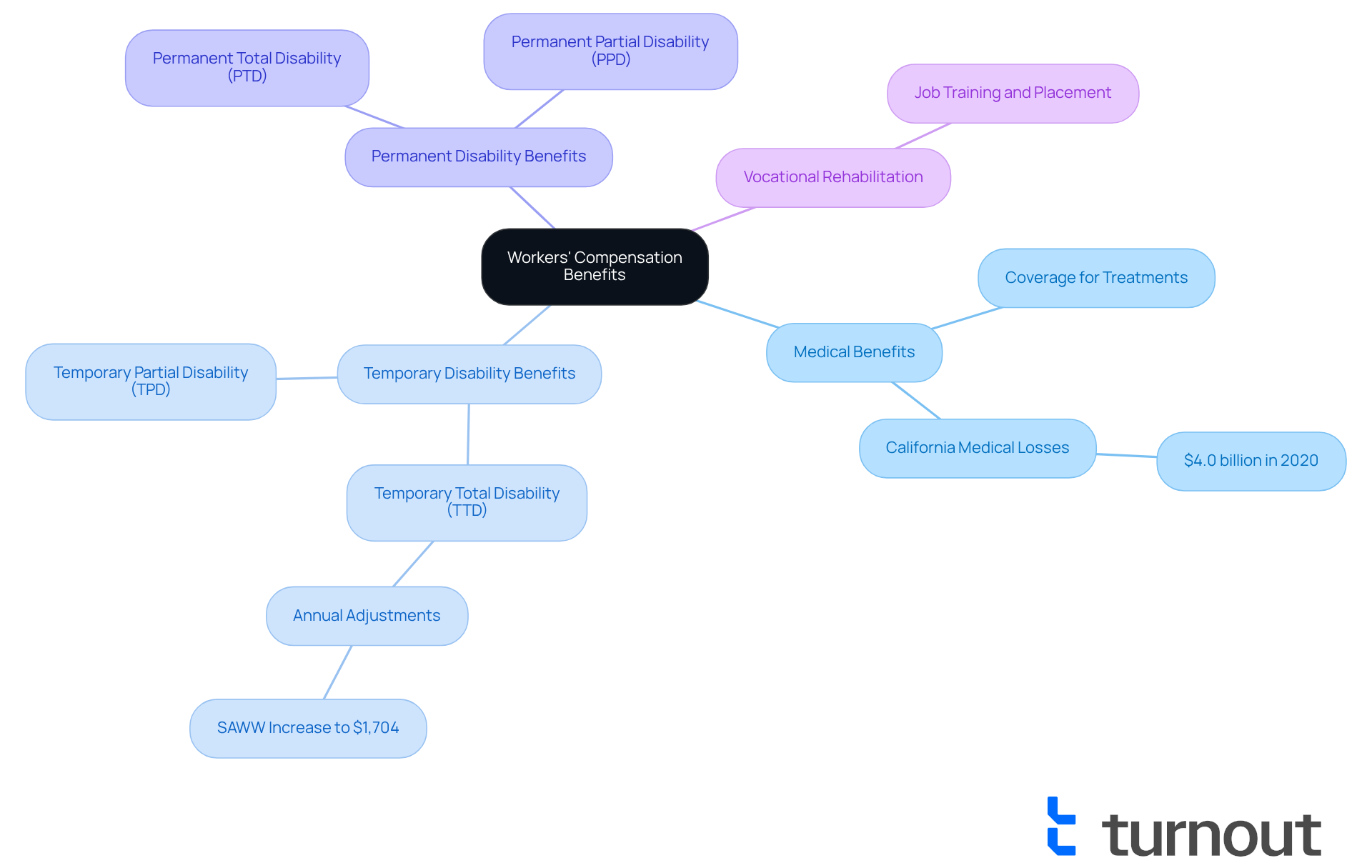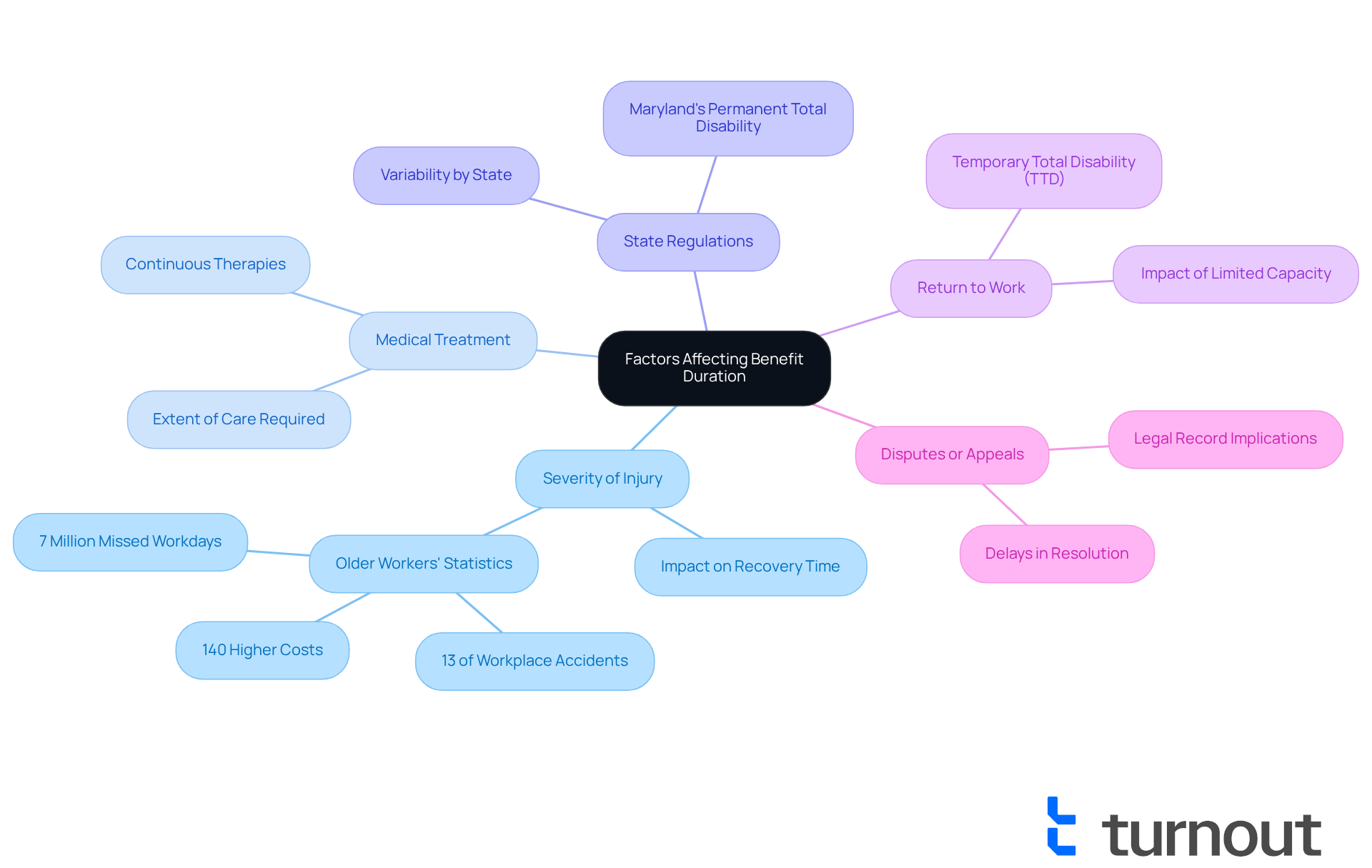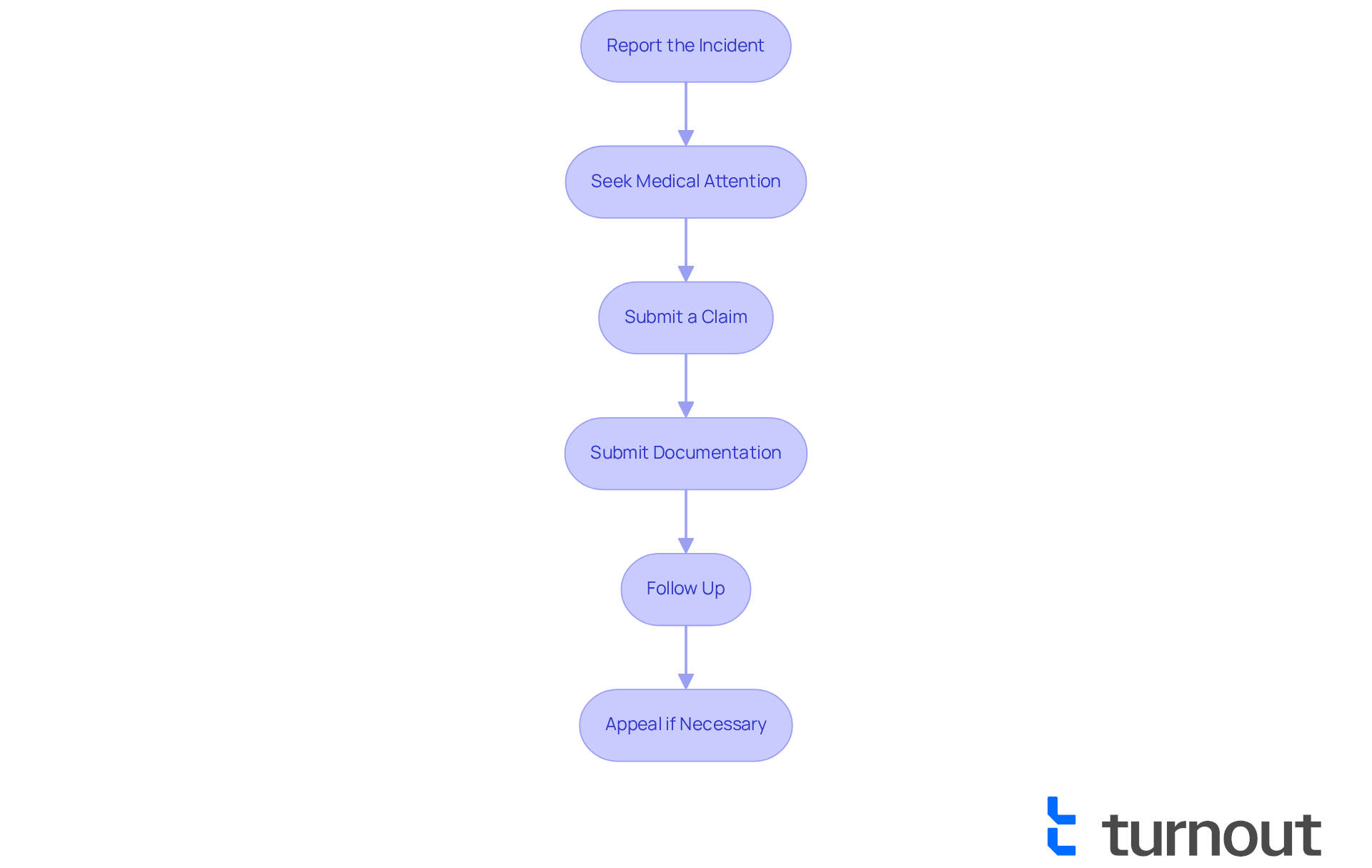Overview
Navigating the world of workers' compensation benefits can be challenging, and we understand that this journey often comes with many questions. The duration of these benefits can vary significantly, influenced by factors such as:
- The severity of your injury
- The type of medical treatment you require
- State regulations
- Your ability to return to work
Typically, more severe injuries lead to longer durations of benefits. If you have ongoing medical needs or face legal disputes, these can further extend the support you receive. It’s essential to grasp these factors, as they play a crucial role in effectively navigating the workers' compensation system.
Remember, you are not alone in this process. We're here to help you every step of the way. Understanding your rights and the available assistance can empower you to make informed decisions during this challenging time.
Introduction
Navigating the world of workers' compensation can feel overwhelming, especially for those grappling with the aftermath of a work-related injury or illness. This essential insurance not only covers medical expenses and lost wages but also presents a complex landscape of benefits and regulations that can vary significantly by state.
We understand that knowing how long these benefits can last is crucial for injured workers seeking financial stability during their recovery.
What factors determine the duration of workers' compensation benefits?
How can you ensure that you receive the support you need?
This article delves into the key aspects of workers' compensation, providing insights that empower you to navigate your claims effectively.
You're not alone in this journey, and we're here to help.
Understand Workers' Compensation Basics
Workers' coverage is a vital type of insurance that provides monetary support to employees facing work-related injuries or illnesses. It aims to cover medical expenses, rehabilitation costs, and lost wages due to an inability to work. Understanding the basics can empower you, and it starts with a few key points:
-
Eligibility: Most employees are covered under their employer's workers' compensation insurance, but eligibility criteria can vary by state. With recent updates in 2025, it's essential to stay informed about changes that may affect your coverage.
-
No-Fault System: Workers' compensation operates on a no-fault principle. This means you can receive benefits regardless of who caused the injury. Such a system simplifies the claims process, allowing injured workers to access necessary support without lengthy disputes. We understand that quick notification of ailments can lead to faster recovery periods, underscoring the importance of prompt communication.
-
Coverage Limits: While benefits typically cover medical expenses and a portion of lost wages, they may not encompass all damages, such as pain and suffering. According to the National Council on Compensation Insurance, the average cost for all claims combined for accidents that occurred in 2021-2022 was $44,179. This highlights the financial implications of workplace injuries.
Getting acquainted with these fundamentals can help you navigate the complexities of the workers' support system more effectively. Remember, a significant portion of claims involves legal assistance, which can complicate the process and ultimately determine how long workers comp can last. You are not alone in this journey; we’re here to help you every step of the way.

Explore Types of Workers' Compensation Benefits
Workers' compensation benefits encompass various types, each designed to address specific needs arising from workplace injuries. We understand that navigating these options can be overwhelming, but we're here to help you find the support you need.
-
Medical Benefits: These cover all necessary medical treatments related to your injury, including hospital visits, surgeries, and rehabilitation services. For instance, in California, insurers paid out $4.0 billion in medical losses in 2020, highlighting the substantial financial support available for injured workers. Furthermore, insurers disbursed $3.7 billion in compensation in the same year, further emphasizing the assistance accessible to those impacted.
-
Temporary Disability Benefits: This category provides partial wage replacement for employees temporarily unable to work due to their injuries. It is further divided into:
- Temporary Total Disability (TTD): For those completely unable to work, with benefits adjusted annually based on the State Average Weekly Wage (SAWW). As of January 1, 2025, California's SAWW increased from $1,642 to $1,704, reflecting a nearly 3.8% rise. This increase will influence the maximum and minimum weekly earnings for TTD support, ensuring that you receive suitable compensation during your recovery.
- Temporary Partial Disability (TPD): For those who can work but at a reduced capacity, ensuring some income continuity during recovery.
-
Permanent Disability Benefits: These are offered to employees who suffer lasting impairments affecting their ability to work. This can be classified as:
- Permanent Total Disability (PTD): For individuals who can no longer work at all.
- Permanent Partial Disability (PPD): For those who can still work but have a permanent impairment, which may require ongoing medical support.
-
Vocational Rehabilitation: This assistance helps employees return to work, including job training and placement services, crucial for those needing to transition to new roles due to their injuries.
Grasping these advantages is crucial for assessing eligibility and successfully seeking the assistance required during your recovery. Industry leaders highlight the significance of remaining aware of alterations in employee injury policies, as these can greatly influence the benefits accessible to injured individuals. As highlighted by Keenan Risk Management, modifications in TTD assistance are closely linked to fluctuations in the SAWW, emphasizing the necessity for you to stay informed about changing regulations that may influence your entitlements. Remember, you are not alone in this journey; support is available to guide you through.

Identify Factors Affecting Benefit Duration
Navigating the complexities of workers' compensation benefits can be overwhelming. Several factors can significantly influence how long workers comp can last, so understanding how long can workers comp last can empower you in your journey.
-
Severity of Injury: More severe injuries often lead to longer benefit periods, as recovery may take more time. For instance, individuals aged 60 and above, who represent only 13% of workplace accidents, frequently face ailments that are 140% more expensive than those of younger employees. This results in prolonged recovery periods and assistance durations. Additionally, this demographic contributes to nearly 7 million missed workdays each year due to work-related accidents, emphasizing the profound impact of serious incidents on workforce productivity.
-
Medical Treatment: The type and extent of medical care required can also affect the duration of assistance. Continuous therapies, such as rehabilitation or surgeries, may prolong the benefits period, especially for serious conditions that demand extensive care.
-
State Regulations: Each state has specific laws governing the duration of assistance, including maximum limits for temporary and permanent disability payments. For example, in Maryland, the length of assistance is closely tied to the severity and type of injury, with permanent total disability allowances providing ongoing support for individuals unable to work for their lifetime.
-
Return to Work: If you are able to return to your duties, even in a limited capacity, your support may be reduced or discontinued. Temporary Total Disability (TTD) assistance, for example, continues until you reach maximum medical improvement or can return to work, which leads to the question of how long can workers comp last.
-
Disputes or Appeals: It's common to face disagreements regarding your claim or the need for an appeal, which can delay resolution and extend the duration of assistance. Cases involving formal hearings or disputes create extensive legal records, potentially prolonging the process and maintaining benefits for a longer period. The impact of legal actions on employee records can significantly influence the duration of assistance.
We understand that these factors can feel daunting, but knowing them can help you navigate your situation more effectively. You are not alone in this journey, and we’re here to help you anticipate the potential duration of your benefits.

Navigate the Workers' Compensation Claims Process
Navigating the workers' compensation claims process can feel overwhelming, but you are not alone. By following these essential steps, you can take control of your situation and work towards obtaining the benefits you deserve.
-
Report the Incident: It’s crucial to inform your employer about the accident as soon as possible. Most states require this notification within a specific timeframe, typically within 30 days. Remember, failing to report promptly can lead to complications, including potential denial of your claim.
-
Seek Medical Attention: Your health is the top priority. Obtain the necessary medical treatment for your condition, and ensure your healthcare provider documents all aspects of your situation. Thorough documentation is vital for your claim.
-
Submit a Claim: Take the time to fill out the employee injury claim forms correctly. This involves providing detailed information about your injury, the medical treatment you received, and any witnesses to the incident. It's important to note that almost 60% of employee claims for benefits are rejected, often due to incomplete or flawed reporting.
-
Submit Documentation: Include all relevant documentation with your claim, such as medical records, bills, and any correspondence with your employer. Comprehensive documentation can significantly strengthen your case.
-
Follow Up: Stay in regular contact with your employer and the insurance company to ensure your claim is being processed. Being proactive in providing any additional information they may request can help expedite the process.
-
Appeal if Necessary: If your claim is denied or you disagree with the compensation granted, remember that you have the right to contest the decision. Familiarize yourself with your state’s specific procedures for appeals, as these can vary significantly.
By following these steps, you can effectively navigate the workers' claims process. Timely reporting and thorough documentation are key factors in securing rightful compensation for job-related injuries or illnesses. We understand that this journey can be challenging, but you are taking the right steps towards getting the support you need.

Conclusion
Understanding the intricacies of workers' compensation is essential for any employee facing work-related injuries or illnesses. This article has explored the fundamental aspects of workers' comp, from its no-fault system to the various types of benefits available. Knowing your rights and the support you can access during recovery is crucial.
Key factors influencing the duration of workers' compensation benefits include:
- The severity of the injury
- State regulations
- The nature of medical treatment required
The claims process has been outlined, providing a step-by-step guide to help you effectively navigate your journey toward obtaining rightful compensation. By staying informed and proactive, you can significantly enhance your chances of securing the benefits you need.
The significance of understanding workers' compensation cannot be overstated. It empowers you to advocate for yourself and highlights the broader implications of workplace safety and support systems. As regulations evolve and the landscape of workers' compensation changes, remaining vigilant and informed is essential. We encourage you to take action today by familiarizing yourself with these processes and advocating for your rights. You are not alone in this journey, and being prepared can make all the difference should the need arise.
Frequently Asked Questions
What is workers' compensation insurance?
Workers' compensation insurance provides monetary support to employees facing work-related injuries or illnesses, covering medical expenses, rehabilitation costs, and lost wages due to an inability to work.
Who is eligible for workers' compensation?
Most employees are covered under their employer's workers' compensation insurance, but eligibility criteria can vary by state. It's important to stay informed about any changes that may affect your coverage.
How does the no-fault system work in workers' compensation?
Workers' compensation operates on a no-fault principle, meaning that benefits can be received regardless of who caused the injury. This simplifies the claims process and allows injured workers to access support without lengthy disputes.
What types of expenses are covered by workers' compensation?
Workers' compensation typically covers medical expenses and a portion of lost wages, but it may not cover all damages, such as pain and suffering.
What was the average cost of claims for workplace injuries in 2021-2022?
According to the National Council on Compensation Insurance, the average cost for all claims combined for accidents that occurred in 2021-2022 was $44,179.
How can legal assistance impact the workers' compensation process?
A significant portion of claims involves legal assistance, which can complicate the process and ultimately determine how long workers' compensation benefits can last.




